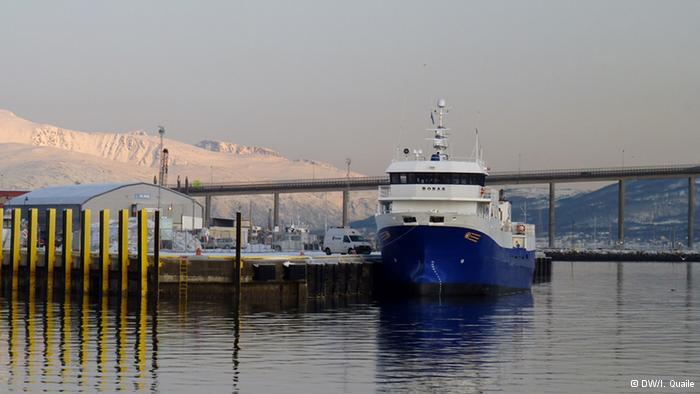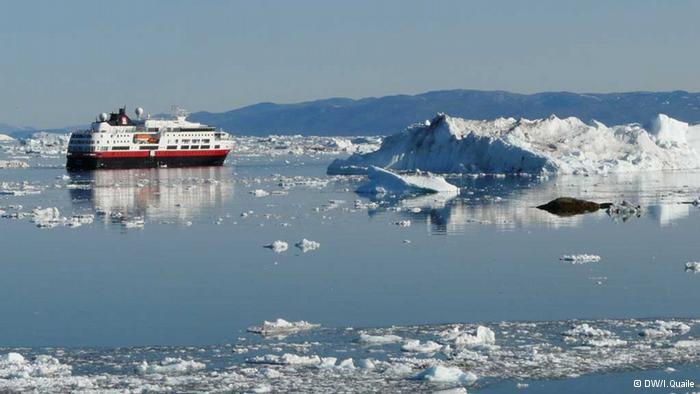Arctic infrastructure cannot keep pace
The Russian response to Greenpeace’s protest at the Arctic Prirazlomnoye oil rig made it clear to a lot of people that in spite of environmental concerns, the commercialization of the region is proceeding “full speed ahead”and enjoying top political priority. The controversial rig went into production at the end of the last year. Shipping has also increased dramatically in Arctic waters in the last few years, with international freight companies using the Northern Sea Route along the Russian coast to transport gas and other commodities. This reduces the distance between Shanghai and Hamburg by around 6,400 kilometers, compared with the usual route via the Suez Canal. Tourism is also on the up, with an increasing number of cruise ships making their way through Arctic waters during the summer months. What happens if one of these ships sinks? When the Costa Concordia cruise ship hit rocks off the italian island of Giglio in January 2012 and tipped onto its side, the risks of this kind of tourism became graphically clear. The thought of something like that happening with an iceberg in the remote regions around Spitsbergen or Greenland doesn’t bear thinking about. But that, of course, is exactly what we have to do with a view to minimising risks for people and the environment.
The Arctic Institute Center for Circumpolar Security Studies has examined existing infrastructure in the six Arctic coastal states (USA, Canada, Greenland/Denmark, Iceland, Norway and Russia). I attended a workshop as a side-event to the Arctic Frontiers conference in Tromso in January, where the initial results were presented. They should really set the alarm bells ringing.
Kathrin Keil from the IASS Institute for Advanced Sustainability Studies in Potsdam, Germany, looked at developments in the oil and gas sector. She warned that the unpredictability and variability of weather and ice conditions would severely limit the options for responding to an oil accident in the region. The ice cover in May can be between 30 and 90 percent, she explained.
The ice-free period can be as short as one month or as long as nine. To date, there is no adequate technology available to successfully deal with the results of an oil spill in Arctic waters. The Institute also says the ‘Oil Spill Response Plan’ provided by Gazprom for the Prirazlomnoye rig lacks detail. The rig is located close to several nature reserves and Kail warns that these areas would be extremely vulnerable if oil or fuel were to spill. She argues for the tightest possible safety regulations, given that this is the first offshore oil platform to go into operation in the Arctic.
Not enough icebreakers
The existing infrastructure is also inadequate for the increase in Arctic shipping, says Malte Humpert, Executive Director of the Arctic Institute. He says the icebreaker fleet is not big enough to support the growing number of vessels sailing through Arctic regions.
The increase in the number of cruise boats, especially near the Norwegian Spitsbergen archipelago and off the west coast of Greenland, is another cause for concern. If a cruise ship carrying 3,000 people were to collide with an iceberg near the popular tourist town Ilulissat, the existing search and rescue capacity would not be sufficient to cope. The available planes, helicopters and ships would be too few and take too long to reach the accident site, says Arctic Institute’s Marc Jacobsen.
With just 4,500 residents, Ilulissat would be unable to provide adequate medical treatment or shelter for people affected by the crash. Oil and other toxic chemicals dumped by the damaged vessel would be very difficult to clean-up. There is also a shortage of satellite, internet and mobile phone connections, meaning communication would be limited.
Politicians are prepared to take risks
The risks of the increasing commercialization of the Arctic are high on the priority of the region’s politicians, says Magnus Johannesson, Director of the Permanent Secretariat of the Arctic Council . In an interview at his office in Tromsø he stressed to me the importance of ongoing negotiations aimed at introducing a ‘Polar Code’ to regulate Arctic shipping. It is set to come into effect in 2016. Johannesson also referred to the SAREX exercises conducted in 2013. These simulated a shipping accident to test search and rescue capacity. But Marc Jacobsen from the Arctic Institute says the exercise was too small in scale to provide a realistic picture of readiness. There were only 250 people on the vessel used in the mock accident.
“I think everyone is aware that there could be better infrastructure, but these are the first steps,” Johannesson told me . “The Arctic states are very aware of that and doing their best to speed this up”.
Disaster in the Arctic: a possibility
Anton Vasiliev, Russia’s ambassador to the Arctic Council, assumes his country will have proper infrastructure in place along the Northern Sea Route within the next few years. Iceland’s Foreign Minister Gunnar Bragi Sveinsson also told me in an interview in Tromso he was confident that security and response infrastructure would be improved.
“In the end we are always worried about the ocean around Iceland, so the environment and security matter. The possibility of a disaster in the Arctic is why we are paying so much attention to the region,” he told me. “The attention to the economic potential of the Arctic is growing fast. But I don’t think it is moving so fast that we cannot manage it.”
But environmental groups are increasingly concerned about commerical activity in the Arctic. I noticed a distinct lack of ngo participation at the Arctic Frontiers event this year. The price of conference attendance seeems to be one factor that reduces the number of ngo people attending. On the official programme, it seems only one ngo is officially invited to speak each year. This year, it was WWF’s turn, and Nina Jensen the CEO was on one of the panels. I interviewed her in Tromso and she told me: “With the increasing ship traffic, there is a higher risk of accidents and pollution that will impact both humans and wildlife to a very serious extent. We do not know enough about the marine environment to be able to avoid serious impacts. We do not have adequate regulations in place, and there is no sufficient oil spill preparedness.” While she welcomes the Polar Code, she stresses it is only a first step, and fails to tackle issues such as black carbon pollution, invasive species and the use of heavy fuel oil.
She sees a huge discrepancy between the political rhetoric, with politicians all paying lip service to the need for a better infrastructure to protect the fragile Arctic environment, but taking little action to make this happen in time.
We also talked about the huge paradox that is Arctic oil drilling. Climate change is making it possible – and burning oil, in turn, is creating the emissions which cause climate change. The world needs to get away from fossil fuel, says Jensen. The future of the Arctic has to be renewable.
My article on this is on the DW website: Are we prepared for a catastrophe in the Arctic?

















